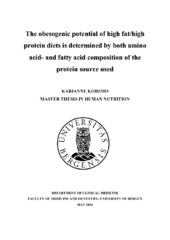| dc.description.abstract | Studies in rodents have found that high protein diets differ in obesogenic potential depending on the protein source used. Varied changes in morphology of brown adipose tissue, an important metabolic organ in mice and rats, have also been observed. Whether diversity in obesogenic potential of different protein sources is caused by amino acid composition, fatty acid composition or a combination of both is unknown. Further, little is known about causes and consequences of changes in brown adipose tissue morphology. Methods: Male C57BL/6J BomTac mice were fed different high-fat/high-protein diets. Casein, cod, pangasius and chicken was used as protein sources, but they also provided different amounts and types of fat to the diet. Pangasius, high in omega-6 fatty acids and with similar amino acid composition as cod, was used to distinguish between the effect of amino acid- and fatty acid composition. Four groups were fed ad libitum, and one group was fed restricted amounts of the chicken-based diet in order to evaluate the impact of weight gain on brown adipose tissue activity and morphology. We studied the effect of different protein sources on body weight development, energy intake, body composition, glucose homeostasis and gene expression in interscapular brown adipose tissue. Body composition was determined by MRI-scan and histology was carried out to examine changes in adipose tissue morphology. Insulin tolerance test and oral glucose tolerance test were performed to assess insulin sensitivity and glucose tolerance. Uncoupling protein-1 (UCP1) expression in brown adipose tissue (BAT) was analyzed by real time-qPCR and immunohistochemistry. Results: A high-fat/high-protein diet based on chicken was obesogenic relative to the one based on cod, whereas the pangasius-based diet had an intermediate effect. Calorie restriction attenuated changes in BAT morphology caused by the chicken-based diet. Similar classic BAT morphology as the one observed in lean chicken- fed mice was also observed in mice fed casein and pangasius. Little differences was observed in gene expression, but immunohistochemistry revealed higher expression of UCP1 in mice fed casein, pangasius and chicken in restricted amounts. Conclusion: Both amino acid- and fatty acid composition determines the obesogenic potential of different protein sources in high-fat/high- protein diets. Changes in BAT morphology and activity are partially decided by body weight, but pangasius as protein- and fat source attenuates this effect. Mice fed casein remains lean with a classic BAT morphology. | en_US |
